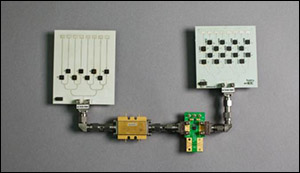Enabling Wireless Virtual Reality
16. 11. 2016 | MIT CSAIL | www.csail.mit.edu
One of the limits of today’s virtual reality (VR) headsets is that they have to be tethered to computers in order to process data well enough to deliver high-resolution visuals. But wearing an HDMI cable reduces mobility.
Fortunately, researchers from MIT’s Computer Science and Artificial Intelligence Laboratory (CSAIL) have recently unveiled a prototype system called “MoVR” that allows gamers to use any VR headset wirelessly.

In tests, the team showed that MoVR can enable untethered communication at a rate of multiple Gbps, or billions of bits per second. The system uses special high-frequency radio signals called “millimeter waves” (mmWaves) that many experts think could someday help deliver blazingly-fast 5G smartphones.
Researchers tested the system on an HTC Vive but say that it can work with any headset.
Read more at MIT CSAIL
Image Credit: Adam Conner-Simons, MIT CSAIL
-jk-




